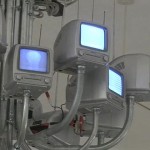With this video we jump back to year 2007, when we covered several shows in New York. Spencer Brownstone Gallery launched its Fall program with a solo exhibition by Ian Burns. Burns was born in Newcastle, Australia. He has been living and working in New York since completing his MFA degree at Hunter College in 2003. The artist had his first solo show at Spencer Brownstone Gallery in 2005 and, since then, has featured in major exhibitions including ‘Greater New York’ at PS1; The Turin Triennial, Castello di Rivoli, Turin; ‘Stereovision’ at South Florida Contemporary Art Museum, Tampa; and ‘New York State of Mind’ at Haus der Kulturen der Welt, Berlin. He is known for sculptural works that combine consumer objects with digital technologies.
Ian Burns’ 2007 solo show at Spencer Brownstone Gallery is titled “The Manner of Work” and featured a series of major new works, such as Himalayas, The End of an Era, Sanitary Gesture, and three live video feed works that re-imagine the classic land art projects of Christo and Jeanne-Claude, Smithson and De Maria.
VTV Classics (r3): Ian Burns: The Manner of Work / Spencer Brownstone Gallery, New York (2007) is the 71st episode in our VTV Classics (r3) series. VTV Classics (r3) highlights the treasures of VernissageTV’s huge archive. Back then published in Standard Definition, these classics are now re-mastered, re-edited and reissued in High Definition.
VTV Classics (r3): Ian Burns: The Manner of Work / Spencer Brownstone Gallery, New York (2007).
–– Right-click (Mac: ctrl-click) this link to download Quicktime video file.
Excerpt from the press release:
Burns’ acclaimed kinetic dioramas and ‘trompe l’oeil’ video works have engaged with subjects as diverse as the war in Iraq, TV culture, colonialism, and art history, and have been featured in important group and solo exhibitions worldwide. For The Manner Of Work the artist summons the spirit of William Morris with a series of major new works that further Burns’ unique formulation of the hi-tech and the handcrafted.
The main gallery will be set up as a kind of fallen Victorian drawing room, replete with large chandelier, sublime mountainous landscape, and patterned wallpaper design. In Himalayas, a wall projection of misty mountaintops is rendered by a teetering stack of tables absurdly suspended from the wall. The End of an Era is a chandelier of sixteen small monitors hanging from the ceiling, all displaying an image of a light bulb created by the perversely archaic method of a camera obscura. And in Sanitary Gesture – Grey, an abstract projected ‘wallpaper’ fills one wall with the patterns thrown by hand sanitizer smeared on the surface of an overhead projector.
At the heart of the artist’s new work lies a concern with the gap between how images are constructed and how their end product is consumed. Noting the contradictory forces at play in the contemporary art world, where the ever more fragmentary art object of a contextual or ‘situational’ art practice coexists alongside a return to highly crafted drawings and paintings, Burns demonstrates how everything can ultimately boil down to a set of signs whose origin often seems arbitrary.
Also included will be a new series of large format photographs of, apparently, mountain, sea, and cloud landscapes, whose monumentality is undermined by accompanying small studio shots that reveal the often abject nature of the images’ construction. And the gallery’s back space will include multiple riffs on contemporary art, including three new live video feed works that re-imagine the classic land art projects of Christo and Jeanne-Claude, Smithson and De Maria from a mixed array of household plumbing and kitchen materials.
We have clearly fallen some distance from Morris’ ideal of an integration of social and aesthetic agendas, and yet, through the ingenuity of his manipulation of materials, and the acuity of his vision, Burns ultimately offers an upbeat assessment of the transformative potential of art.




